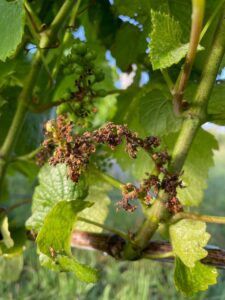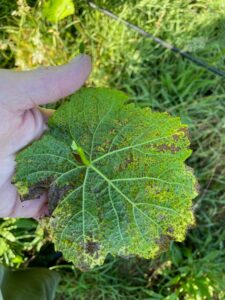19 April 2023
The AWRI helpdesk has received calls this season about necrosis and rot of inflorescences. These symptoms could be caused by a physiological disorder or fungal infection, but could also be the result of a bacterial infection. The purpose of this eBulletin is to raise awareness of the disease bacterial inflorescence rot (BIR), which is caused by the bacterium Pseudomonas syringae pv. syringae (PSS). Awareness of this disease may be relevant when planning pruning practices.
About this pathogen
Pseudomonas syringae pv. syringae is a low-risk pathogen in dry and warm seasons, but its development and spread is favoured by wet conditions. It can be particularly damaging in cool regions and humid conditions. Rainfall and the movement of water across leaf surfaces creates the ideal environment for PSS to spread across plant surfaces. The bacterium is understood to enter grapevine leaves through the stomata and spread via the xylem within the shoot. More information about PSS and BIR is available in the AWRI fact sheet: Recognising and understanding bacterial inflorescence rot.
Symptoms in grapevines
Symptoms of BIR (Whitelaw-Weckert et al. 2011) typically first appear at flowering, about 60 days after budburst. They include:
- brown longitudinal striations on shoots, rachises, leaf petioles and veins
- necrotic rachises and abscission of up to 60% of inflorescences
- leaves covered in small dark spots with yellow halos, which enlarge, becoming irregular in shape and bounded by small leaf veins, eventually merging until much of the leaf is covered and the leaf senesces
- affected tissue splitting due to becoming dry and brittle
- drops of bacterial ooze near shoot lesions.
The AWRI fact sheet Recognising and understanding bacterial inflorescence rot includes a number of images of BIR symptoms.


Leaf and inflorescence symptoms caused by Pseudomonas syringae pv. syringae. Images courtesy of Adrian Utter.
Testing
If symptoms are observed, it is advised that samples are sent to a testing facility to confirm the cause. Testing is most effective on vines showing early symptoms (e.g. leaves showing small dark spots with yellow halos). Testing is available from:
Crop Health Services
Main Loading Dock
5 Ring Road
La Trobe University
Bundoora VIC 3083
Phone: 03 9032 7515
Email: chs.reception@agriculture.vic.gov.au
EMAI (Elizabeth Macarthur Agricultural Institute)
Private Bag 4008
Narellan NSW 2567
Phone: 02 4640 6333
Email: laboratory.services@dpi.nsw.gov.au
Plant Diagnostic Services
Department of Natural Resources and Environment Tasmania
13 St Johns Avenue
New Town, TAS 7008
Phone: 03 6165 3245
Email: plantdiagnosticservices@nre.tas.gov.au
Attention: Alison Dann
Management
Pseudomonas syringae pv. syringae is easily spread on pruning equipment. Where PSS has been identified or is suspected, growers should clean and disinfect vineyard equipment regularly, especially pruning equipment. Disinfecting snips and secateurs between plants is recommended to stop the spread.
There are no agrochemicals registered for control of PSS, but copper is thought to have some effect. The application of copper chelate as a soil drench is said to control the pathogen in the vine, but more research would be required to confirm this.
Anecdotal evidence suggests that conversion from spur pruning to cane pruning can reduce PSS pressure, perhaps because old wood harbouring inoculum is removed. Suckers located on the trunk are often found to be infected with PSS and should be removed. High humidity causes symptoms to be more severe, so actions to open the canopy and promote airflow are beneficial.
AWRI helpdesk
For assistance with grapevine diseases or any other technical viticulture or winemaking topic,contact the AWRI helpdesk on (08) 8313 6600 or helpdesk@awri.com.au.
Acknowledgement
Fiona Constable, David Lovelock, Cathy Todd, Barbara Hall and Melanie Whitelaw-Weckert are thanked for their contributions to the fact sheet.
This work is supported by Wine Australia, with levies from Australia’s grapegrowers and winemakers and matching funds from the Australian Government. The AWRI is a member of the Wine Innovation Cluster in Adelaide, SA.

Further information
Whitelaw-Weckert, M.A., Whitelaw, E.S., Rogiers, S.Y., Quirk, L., Clark, A.C., Huang, C.X. 2011. Bacterial inflorescence rot of grapevine caused by Pseudomonas syringae pv. syringae. Plant Pathol. 60: 325-337.
NSW DPI Agriculture. Bacterial rot of grapevine caused by Pseudomonas syringae. Video available from: https://www.youtube.com/watch?v=mCmOBuedd1U
For other enquiries
please contact
enquiries@awri.com.au
08 8313 6600

